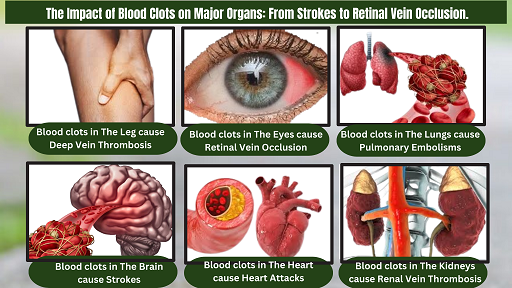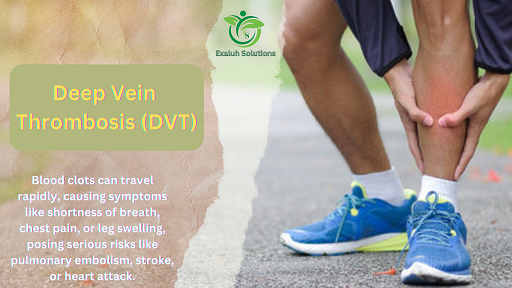Blood Clot
Blood clotting typically involves the formation of a thick substance in blood vessels (arteries or veins). While clotting aids in stopping bleeding during injuries, excessive or uncontrolled clotting can lead to health complications such as deep vein clots, lung clots, and heart attacks.
Blood clot Explained
A blood clot can be described as a semisolid mass of blood cells or other material that forms within a blood vessel causing a blockage. However, the Blood clots protect you from excessive bleeding if you are injured or have surgery.
Nevertheless, blood clots can also happen for some other reasons, such as certain medical conditions and when it happens in such cases, the blood clot can cause symptoms and can be life-threatening.
Function
What do blood clots do?
When blood vessels get injured blood clots act as the body’s way to protect itself. For instance, when you have a cut or shave the blood quickly clots to stop the bleeding.. Sometimes blood clots can form due, to factors like not moving or having certain health issues that raise the chance of clotting. In some cases, it can affect how well blood flows through your body.
Anatomy
What is a blood clot made of?
A blood clot is made up of platelets and fibrin. Platelets are small colourless cell fragments made by bone marrow. Fibrin is a blood protein. It is sticky and may look like long threads. Platelets and fibrin work together to seal off damaged areas of blood vessels.
What does a blood clot look like?
A blood clot resembles a red, gelatinous substance that’s held together by a net-like structure. Upon closer examination, you might notice tiny cell-shaped particles called platelets within the clot. The net-like component is composed of fibrin. The reddish hue of blood clots stems from red blood cells getting trapped within the fibrin as they flow through the site of injury.
Where exactly is the blood clot located?
Blood clots have the ability to develop in parts of the body. Blood clots can form in the veins of the arms or legs a condition known as vein thrombosis (DVT). In contrast, blood clots in the arteries may arise in the lungs leading to an embolism. A blood clot that obstructs blood flow to the brain can result in a stroke while a clot, in the heart can trigger a heart attack.

When might I realize I have a blood clot?
Signs of a blood clot naturally show up when one develops in a vein or artery. Feeling pain in the leg experiencing swelling or noticing changes, in skin colour could indicate vein thrombosis (DVT). Chest discomfort or difficulty breathing may suggest a blood clot, in the lungs or heart.
Complaints and Disorders
What types of issues and illnesses can be linked to blood clots?
Blood clot concerns are connected to a range of health conditions. When you get a cut, your body may form a blood clot to help stop the bleeding. Certain conditions specifically involve blood clots like bleeding disorders and clotting disorders. Additionally, you might acquire problems that raise your chances of getting blood clots.
Bleeding Disorder and Blood Clotting Disorders
People who have a bleeding disorder face challenges, with the ability of their blood to clot properly putting them at risk of bleeding when injured. Bleeding disorders encompass conditions such as Von Willebrand disease, where the mutated gene can be inherited or linked to health issues like cancer or autoimmune diseases. Thrombocytopenia characterized by platelet count and haemophilia, which results from insufficient clotting protein production in the body are also part of this category.
On the other hand, blood clotting disorders, also known as states involve the body forming more blood clots than usual. These disorders can be hereditary. Develop later in life. Factor V Leiden and Prothrombin gene mutation are among the blood clotting disorders each slightly increasing the risk of conditions, like deep vein thrombosis (DVT) or pulmonary embolism.
Antiphospholipid syndrome is a condition where the immune system triggers an increased likelihood of blood clot formation.
What other factors can increase the risk of blood clots?
Many factors can increase the risk of blood clots. For example, people who contracted severe coronavirus disease (COVID-19) in 2019 are at increased risk.
Other factors include:
- Age. People over 65 are at increased risk of blood clots.
- Pregnancy.
- You have obesity.
- I have cancer.
- Are you taking oral contraceptives or hormonal therapy?
- Smoking.
- Cannot move.
Care
Can Blood Clots Be Prevented?
If you are born with an inherited blood clotting disorder, there is nothing you can do to prevent your condition or the blood clots it causes. However, you can reduce your risk of developing a blood clot by:
- See your doctor for an annual checkup.
- Participate in regular cancer screenings.
- Maintain a weight that is healthy for you.
- No smoking.
- Make sure you stay hydrated.
- Consider estrogen-free alternatives to birth control and hormonal therapy.
- Stay active.
Message from Exaluh Solutions. Blood clots can help control bleeding, whether it’s a minor cut, a serious injury, or bleeding after surgery. However, if a blood clot blocks the flow of blood through the body, it can be life-threatening.
Blood clots occur for a variety of reasons, some of which are unavoidable. For example, you may have an inherited (genetic) disorder that increases your risk of developing blood clots. If this is the case, you are probably treating your symptoms with medications or other means. If you are concerned about blood clot formation, please consult your healthcare provider. They will assess your general health and recommend ways to reduce your risk of developing them.

